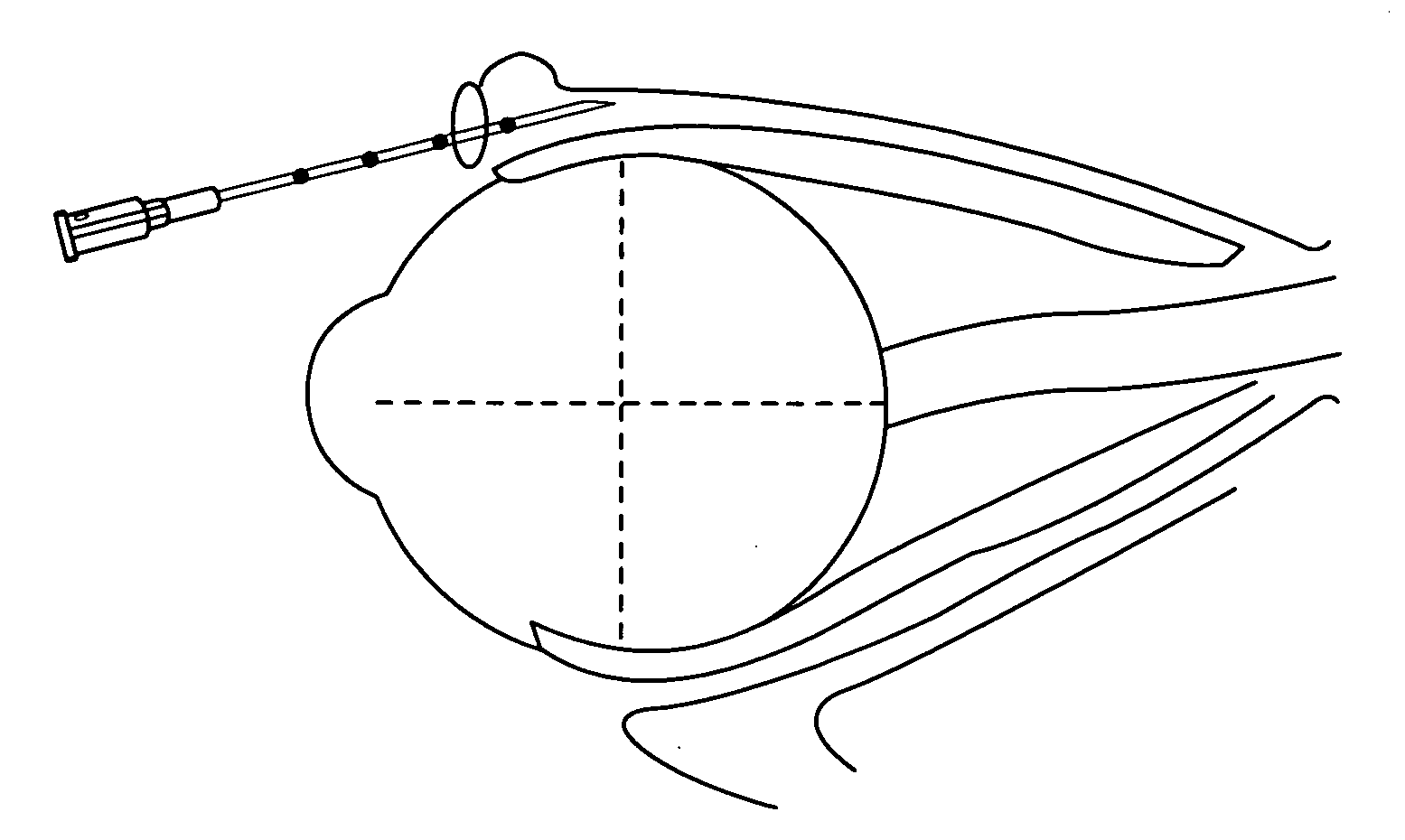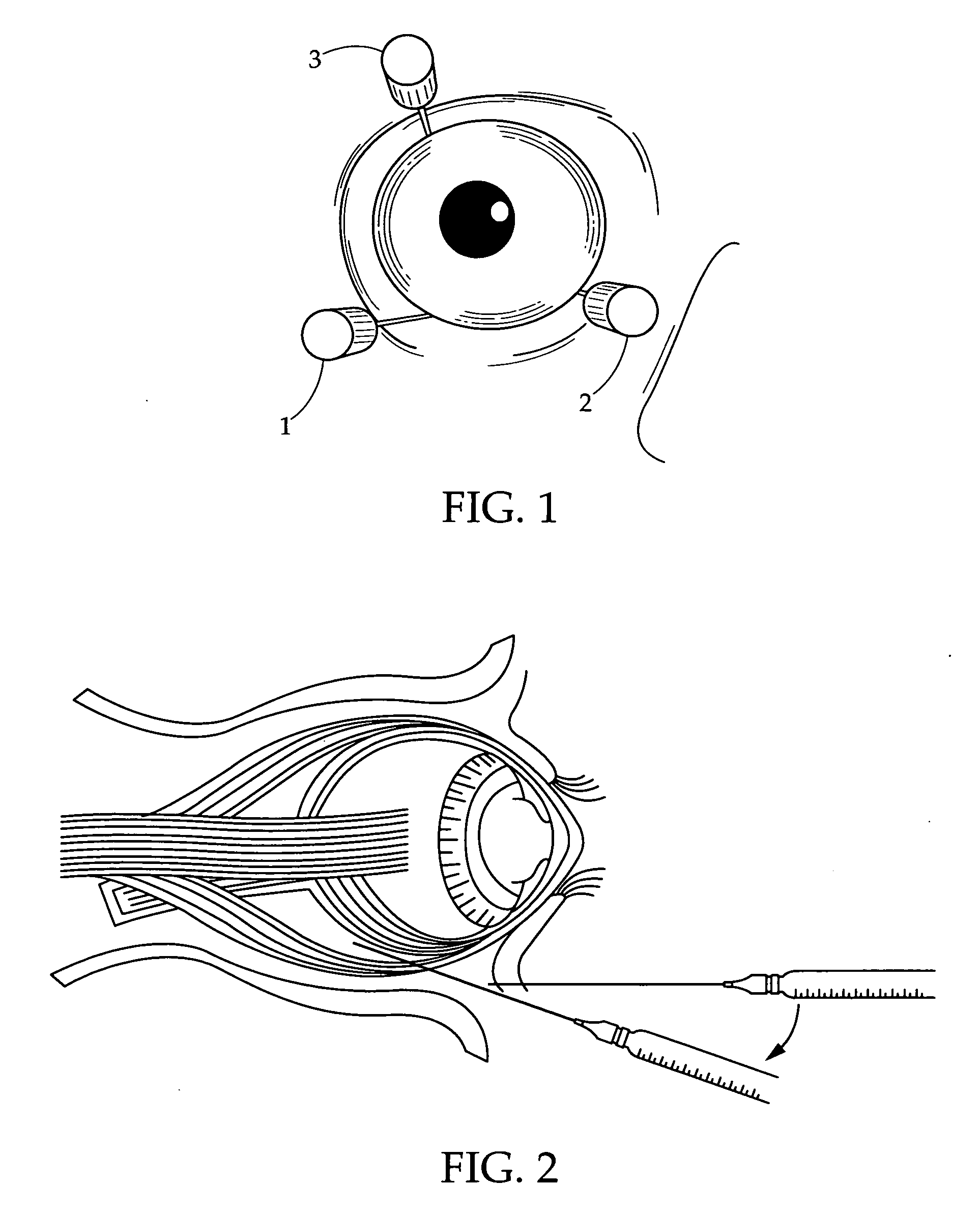Insertion mechanism for use with a syringe
a syringe and needle technology, applied in the field of needles, can solve the problems of orientation recognition, lack of precise and objective needle depth recognition, and loss of exact/objective recognition of needle depth and orientation, etc., to improve patient safety, easy and simple operation, cost-effective manufacturing and production
- Summary
- Abstract
- Description
- Claims
- Application Information
AI Technical Summary
Benefits of technology
Problems solved by technology
Method used
Image
Examples
example 1
Harvey's Technique
[0079]FIGS. 11A-D illustrates use of the instant invention having markings 42 disposed at six and one quarter millimeters intervals along the shaft, and an individual having the cornea right above the orbital rim, and wherein the AL of the globe is twenty-four millimeters. The equatorial plane is therefore twelve millimeters behind the cornea and orbital rim. Therefore when the second marking (i.e. twelve and one half millimeters) (±one half millimeter tolerance) locatable on the instant invention is at the point of insertion, a practitioner knows that the bevel of the needle is at the equatorial plane and that the needle can be redirected per earlier description.
[0080]The significant difference between the technique utilizing the instant invention, and the current use of unmarked needles is objectivity, in that it gives the practitioner the exact location of the bevel / tip and allows the practitioner to make the necessary upward correction that with a decreased ris...
example 2
Harvey's Technique
[0081]FIGS. 12A-D illustrate use of the instant invention having markings 42 disposed at eight millimeters intervals along the shaft, with an individual having the same twenty-four millimeter AL with an equatorial plane at twelve millimeters, but the cornea is four millimeters in front of the orbital rim, (i.e. the insertion point). The tip of the needle has already passed four millimeters when it is inserted, and only has eight millimeters more to advance before being at the level of the equatorial plane.
[0082]Thus a practitioner must consider the redirection change at the eight millimeters mark of the needle, as opposed to the twelve millimeter mark in Example 1. Again, the instant invention will show exactly when the eight millimeters mark is at the level of the initial insertion and consequently, the tip has passed the equatorial plane, thereby allowing the practitioner to make an upward correction.
example 3
Harvey's Technique
[0083]FIGS. 13A-D illustrates use of the instant invention having markings 42 disposed at seven and one-half millimeter intervals along the shaft, and an individual with a long eye with an AL of thirty millimeters and an equatorial plane locatable at fifteen millimeters. In this example, the long eye is less common than the average twenty-three to twenty-four millimeter eye, and has an increased risk for perforation due to a change in direction of the tip taken too early.
[0084]For this example, one must assume that the cornea is three millimeters in front of the orbital rim. As such, a practitioner will know precisely when the tip of the needle will be at the equatorial plane when the fifteen millimeter mark is at the point of insertion, thereby requiring an upward angle change. The unique safety element of the instant invention in providing an exact measurement of the depth of the needle is extremely important especially in this type of long AL eye, because there ...
PUM
 Login to View More
Login to View More Abstract
Description
Claims
Application Information
 Login to View More
Login to View More - R&D
- Intellectual Property
- Life Sciences
- Materials
- Tech Scout
- Unparalleled Data Quality
- Higher Quality Content
- 60% Fewer Hallucinations
Browse by: Latest US Patents, China's latest patents, Technical Efficacy Thesaurus, Application Domain, Technology Topic, Popular Technical Reports.
© 2025 PatSnap. All rights reserved.Legal|Privacy policy|Modern Slavery Act Transparency Statement|Sitemap|About US| Contact US: help@patsnap.com



